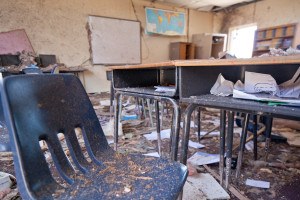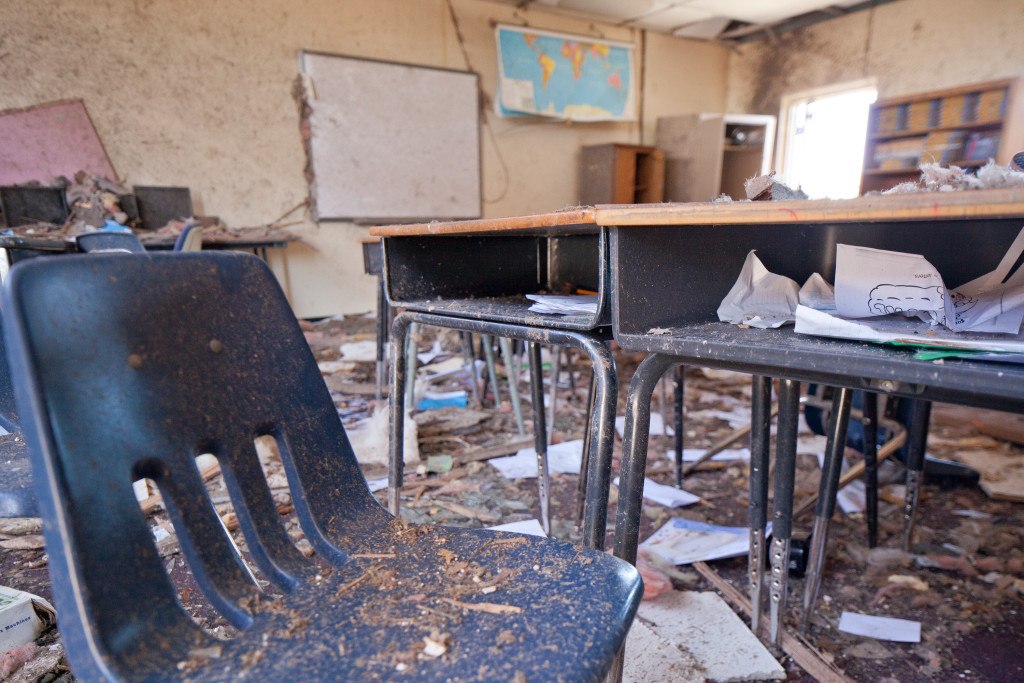An upcoming report prepared for an engineering society will say that an elementary school destroyed by a tornado at Moore, Okla., last spring was poorly designed and could have protected children better if it had been properly reinforced.
Similar construction techniques were used at the Plaza Towers and Briarwood elementary schools, according to a civil engineer who worked on the study. Seven children died when a storm packing winds in excess of 200 mph collapsed the Plaza Towers building last May 20. Two dozen students and teachers were injured at Briarwood.

“Odds are, if the schools had been built right, the walls would not have fallen,” civil engineer Chris Ramseyer told The Journal Record. He and other engineeers spoke with the Oklahoma City newspaper about the report, which was prepared for the American Society of Civil Engineers and Structural Engineering Institute.
The engineers’ report, due for release in the spring, is based on Briarwood’s debris. The Plaza Towers site had been cleared prior to the review team’s arrival and Ramseyer studied photographs of that school for The Journal Record newspaper.
The storm struck on the last day of the 2012-13 school year. Two dozen people were killed, including the seven Plaza Towers pupils.
According to the report on Briarwood’s damage, the school’s steel roof beams were not attached to the walls, many of its cinder-block walls were not properly reinforced with steel rebar and large portions of the walls were not backfilled with concrete. The substandard steel rebar served as a hinge, letting high winds blow walls over, Ramseyer said.
Construction documents obtained by The Journal Record through an open records request show that Briarwood Elementary’s main building was designed in 1984 by a now-defunct architectural and engineering firm whose founders were disciplined for design flaws in other projects.
Ramseyer, an associate professor of civil engineering at the University of Oklahoma and a nationally recognized expert on the use of concrete, said debris from Briarwood showed the school wasn’t built properly.
“(At Briarwood) we found one horizontal steel beam that was designed as a support beam for masonry over the entrance to two classrooms,” Ramseyer said. “But there was no connection from the beam to the masonry, anywhere. No connection. The beam was just sitting there on the walls. Only gravity held it in place. Obviously, that’s not being built to code.”
Ramseyer, director of the university’s Donald G. Fears Structural Engineering Lab, is one of the authors of the ASCE-SEI report. With support from the Federal Emergency Management Agency, Ramseyer was part of an eight-person ASCE group allowed to examine and photograph rubble from the school.
He said debris from the Briarwood site showed many of school’s walls were built using only 4- to 8-inch vertical overlaps of steel reinforcement – rebar – inside the cinder blocks rather than 20- to 30-inch overlaps called for by the International Building Code for reinforced masonry.
Bill Coulbourne, a Delaware engineer who is the principal author of the report, drew similar conclusions.
“There were places in the building that failed that we should have seen more resistance in the building elements,” he said. “There wasn’t a lot of steel in any of the masonry walls. There were not very long splices between metal reinforcing bars.”
Oklahoma City architect John Joyce, a principal with Engineering Solutions and also a member of the review team, told the newspaper the “obvious thing” was trouble with the concrete masonry walls. In January, he told Oklahoma City television station KFOR that stronger construction could have saved lives.
“They may not have needed a full-blown FEMA shelter to save those kids. Maybe they just needed it a little bit better than what it was,” he said.
Plaza Towers, built in 1965, had its debris removed before the engineering team had a chance to examine it. Ramseyer reviewed photographs of the damage provided by storm victims’ families and media organizations and said it showed problems similar to Briarwood’s.
Prior to 1984, when Briarwood was built, building inspectors did not review masonry work as they do now, said David Adcock, the director of plan review, inspection and permits for Oklahoma City.
Danni Dunn-Legg, whose son Christopher died at Plaza Towers, said she was angry and concerned.
“If the ceiling and the walls are stacked like a deck of cards and you remove one element, it falls,” she told the newspaper.
Ramseyer said it was divine intervention that kept the death toll from being higher.
“As a human, what I see is, God chose to save them,” he said. “Because this structure didn’t. Bless those teachers who tried to protect their kids, because the building just did not do its job.”
Was this article valuable?
Here are more articles you may enjoy.


 Tesla, EEOC Plan Talks to Settle Factory Racism Suit
Tesla, EEOC Plan Talks to Settle Factory Racism Suit  Musk’s X Probed by UK Over Grok’s Thousands of Sexualized Images
Musk’s X Probed by UK Over Grok’s Thousands of Sexualized Images  Hyundai Unveils New Humanoid Robot for Work in Car Factories
Hyundai Unveils New Humanoid Robot for Work in Car Factories  The 14 Global Trends That Will Shape the Climate in 2026
The 14 Global Trends That Will Shape the Climate in 2026 